Victoria’s rivers are now open and October is a great time to hit the mountain streams stalking wild browns and energetic rainbows.
Victoria has myriad river and streams worth wading during spring that produce fish - it all just comes down to how far you’re willing to travel for a day of stalking.
Fast flowing rivers streaming from Victoria’s high country are at their peak with hungry trout, so whether it’s just a day trip or for the weekend, there are plenty of river and stream options for all.
Just an hour from Melbourne’s CBD, anglers can enjoy walking the banks of the Yarra River’s upper reaches around Warburton and beyond. There are plenty of small feeder creeks in the area that are also worth a look too.
Further up the mountains, the Goulburn River is a Mecca for trout anglers and with good bank access along its entirety this river will see plenty of attention over the next few months. The Goulburn is a favourite river of mine and while it continuously produces some good fish the hard work will still be needed to be put in. Wading across rocks and tree logs are just part and parcel of a day’s work but all in all providing you’re casting into the deep pools and snaggy banks you should find success.
One popular and effective location is the junction where the Goulburn meets the Acheron. Access is limited but still worth the effort. Even still the Acheron itself produces some nice fish if you’re willing to do a bit of wading in the river.
Nearby Snobs Creek holds good quality brown trout in some tight water. Wading is necessary to access these delightful pocket but worth the effort. A stealthy approach is required in all rivers as the trout are spooked easily.
If you’re still looking for that more secluded location and don’t mind a bit of a drive, then above lake Eildon there is a plethora of rivers full of fish worth dangling a line into.
Big River along the Eildon-Jamieson Road is a fast flowing river but worth the drive. You must have your hiking gear at the ready as most of the country is mountainous. The river has good access from the camping grounds and from these locations you can wade upriver casting into the swollen pools.
Another great river is the Howqua located on the Howqua Track at Sheepyard Flats Camp ground. Although the Howqua can be accessed from many locations, at Sheepyard it is far easier. The river is fast flowing but contains plenty of deep pools which all hold fish. From the bank access is great and waders are necessary. You will be trundling though heavy brush, over snags and in the river but it is worth every minute when you get a hook-up.
This river deserves exploring and if you’re going to do it as a day trip, I highly recommend getting there early to give yourself enough time to thoroughly work a good section of the river.
If you’re not keen on travelling too far the Tarago and Toorongo rivers around Noojee are also magnificent waterways. From the main roads you have good access to the rivers, even in the town at the local park the river winds through it and though you wouldn’t think you could pull a fish from there, you can. If fishing the Tarago I do suggest a little exploring as you will tend to find some better water further away from the roads.
While there are hundreds if not thousands of rivers and streams to explore, the few mentioned above provide good easy bank access to anglers.
These rivers and streams are a fly angler’s delight, awaiting the local insect hatch just to be able to match the hatch is an art form in itself. Lure casters have also crafted their techniques using some of the newest and most innovative gear on the market.
Today, tackle shops are awash with gear and most of the time it is confusing which lure to purchase. Each angler will have their own successful technique and lure that they repeatedly use. This comes down to a confidence thing, once a fish has been caught on a particular lure, that one lure becomes a favourite setting the benchmark for future catches.
When it comes down to it, lure fishing is just as an art form as fly fishing. The same concepts apply to reading the water and knowing where fish will be, this also applies to the level of gear used.
Successful lure fishing requires the use of graphite fishing rods for castability, accuracy and precision. For all my adventures my outfit consists of a 7’ Wilson Venom Micro Light 1-3lb mounted upon a Shimano Sustain 2500, a well balanced outfit to flick such small, almost weightless lures. Within this, the reel is tightly spooled with 4lb braid and a rod length of 5lb fluorocarbon leader. The reason for such light line is that I’m throwing such lightly weighted lures. Hard bodies weighing anything from 1/16-1/8oz, spinners of 1/32-1/6oz challenge any combination. The lighter line enables the outfit to cast such light lures with minimal effort bestowed when casting. By having the correct gear for the job will aid in all aspects of lure fishing from twitching a hard body along the edge of a fallen tree to winding a spinner down the rapids.
When it comes to selecting a lure firstly it pays to have a selection to cover all bases. While spinners are the most versatile and inexpensive lure available hard body lures are available in a range of diving depths.
There is an abundance of spinners in many colours available. While I have a election from fluoro orange and pink to brown and rainbow trout patters and black my choice is the range of Wordens Rooster Tail 208 spinners. For the most part, the Rooster Tail is the perfect lure for all stream craft. The action of the lure is the forward spinning blade which provides plenty of flash on the retrieve. The most effective way to fish an inline spinner is a slow, steady retrieve allowing the blade to throw flash in all directions. An alternative method is to pause on the retrieve, forcing the spinner to stop rotating allowing it to drop erratically downward like a sick or injured insect or minnow.
Hard bodies on the other hand use a different technique. Hard Bodies are available in floating, suspending and sinking and while most of the rivers and streams are shallow, I highly recommend a floating lure in these circumstances.
Hard bodies can be cast and retrieved but depending on the depth of the diver you may hit the snags or bottom and get hung up. The correct method with hard bodies in small streams is to wind, jerk, pause, jerk and wind. This will have the lure dive and on the pause slowly float before being ripped down again.
There is no need for a large lure either. For most of my work lures in the 50-70mm range are suitable. I have been fond of the Yo-Zuri 50mm Pins Minnow in the BWRT and BT colours. This lure has a great action and can be worked in fast and slow water. The retrieve can be varied but the action this lures give off is a trout attracting machine.
There are many fishing options when it comes to fishing rivers and streams but one thing’s for sure, spinning is fast becoming extremely popular. With the trout season alive and well and the rivers full, grab the map or your GPS and find a nice secluded river to cast into.
Reads: 22654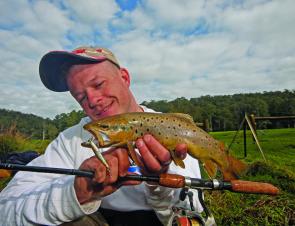
The author displays a stream trout caught on a Yo-Zuri 50mm Pins Minnow.
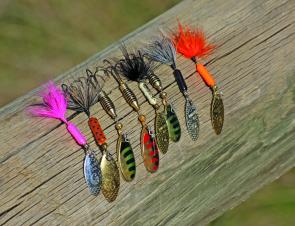
Spinners are also a worthy lure. Wordens Rooster Tails and Celtas continue to be trout producers.
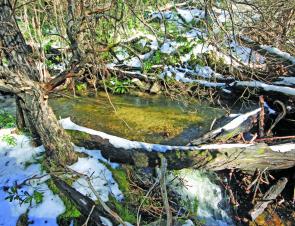
Just prior to trout closing the Alpine streams can become snow covered. Though it may be cold there are hungry trout ready to take a lure.


Some locations are difficult to access and only bank fishing is possible. Still, casting to the holes can lead to some good catches.
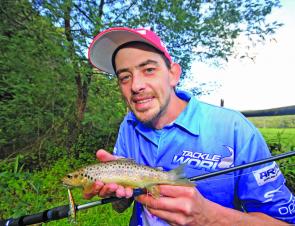
Small streams hold a variety of fish sizes; here Kurt Emmerson displays a typical rive fish.
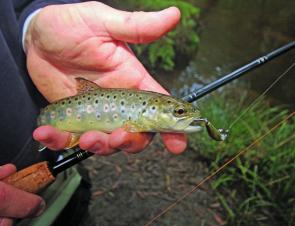
I didn’t say they are all big, but they are fun nonetheless.

Regardless of size, fishing the alpine streams can be a lot of fun.

Trout can be ferocious at times. Small brown trout patterns are deadly.
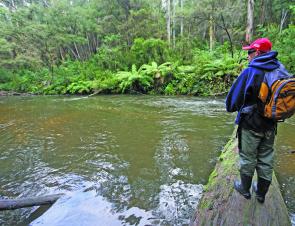
Submerged logs in the middle of the river are the perfect target. There will be an abundance of trout hiding here.
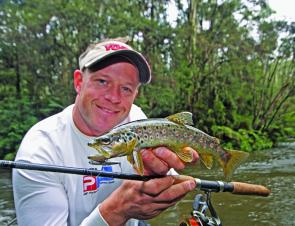
Another nice fish caught on the back of a rapid.
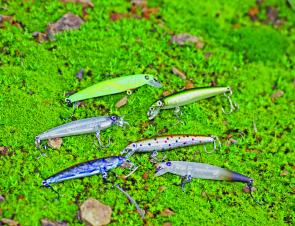
The author’s selection of Yo-Zuri Pins Minnows that have proved deadly on stream trout.




